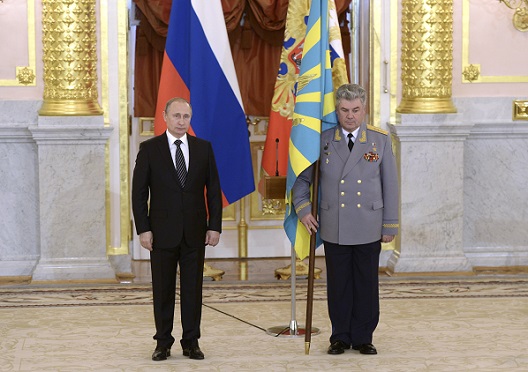 Shortly after Russia announced it would withdraw most of its forces from Syria, the first Russian military aircraft left Hmeimim air base. This was quite abrupt and unexpected but it was not shocking, nor did it indicate that Russian fortunes and commitment in Syria have collapsed. More likely, the withdrawal shows Russia’s sufficient if incomplete satisfaction with the military situation in Syria, and its comfortable and confident diplomatic position in negotiating a favorable political settlement. Additionally, Russia will keep forces and its main air and naval installations in Syria, which allows it to resume operations with relative ease and rapidity. Measured against the track records of the main actors in Syria, this is not a bad outcome for Russia at all.
Shortly after Russia announced it would withdraw most of its forces from Syria, the first Russian military aircraft left Hmeimim air base. This was quite abrupt and unexpected but it was not shocking, nor did it indicate that Russian fortunes and commitment in Syria have collapsed. More likely, the withdrawal shows Russia’s sufficient if incomplete satisfaction with the military situation in Syria, and its comfortable and confident diplomatic position in negotiating a favorable political settlement. Additionally, Russia will keep forces and its main air and naval installations in Syria, which allows it to resume operations with relative ease and rapidity. Measured against the track records of the main actors in Syria, this is not a bad outcome for Russia at all.
Since Russia’s intervention began on September 30, 2015, many officials and analysts tended to read it as a sign of Russian weakness and hubris. Several western analysts and officials described the intervention itself as a quagmire–a repeat of Russia’s disastrous Afghanistan war–even though in Syria there is no equivalent of the Stinger anti-aircraft missiles that helped defeat the Soviets, or any Western-backed, organized proxy effort against Russia at all. In the following weeks, Russian bombing was described as ineffective, on the grounds that it was inaccurate and had returned very little territory to Syrian regime control, despite the fact that reasserting regime authority over Syria was not really Russia’s objective.
The wisdom of Russia’s actions was ultimately determined not by its opponents’ wishful thinking but by their reactions, which ranged from non-existent to ineffective. Russia was able to bomb opposition and civilian targets unopposed for months, inflicting enormous damage and casualties and straining the critical relationship between rebel groups and the local populations that host them. Eventually, this attrition and pressure enabled regime, Shia militia, and Hezbollah forces (reportedly with Russian artillery support) to conduct successful shaping operations around key rebel areas. By February 2016, the regime and its allies had stabilized several weak fronts along which the opposition had only recently threatened core regime territory, and cut rebel supply lines into Aleppo city. Shortly after that, Russia and the United States brokered a cessation of hostilities and, critically, the regime and rebels were both forced to accept it.
In summary: the Russian intervention saved the regime from likely military collapse and extinction; inflicted great damage on its enemies including moderate and Islamist rebels alike; positioned Russia as an equal if not senior partner to the United States in Syria; demonstrated its ability to restrain the regime; and showcased its military hardware and capability. The only challenge Russia has faced recently is keeping the Syrian regime’s maximalist political demands in check, lest they disrupt a Russian-controlled political process and the cessation of hostilities. Regime forces continue to violate the ceasefire, including by launching ground operations against rebel groups who are party to the Russia-brokered agreement. These are not great difficulties however: regime announcements that Assad’s fate is a red line and that the regime would retake all of Syria are annoying but do not indicate Russian failure, only the regime’s inability to grasp the realities of its position and the limits of Russia’s support.
The Russian (partial) withdrawal should therefore be analyzed in context. Russia’s two main objectives have been met: preventing the regime’s collapse and positioning Russia as the key power broker. From here on, Russia would be wise to focus on protecting those achievements, and appears to be doing so. That means withdrawing enough to communicate to the regime the limits of its patience and commitment, while retaining enough presence to preserve the military option against the insurgency and exercise leverage over Assad and the negotiation process. A resumption of large-scale hostilities would jeopardize these gains, and may occur regardless of Russia’s wishes. Still, Russia could simply resume its bombing campaign if that happens.
It is tempting to see weakness or hubris behind every Russian action. This probably stems from a failure to see things from an opponent’s point of view, including how they might define success. The United States has refused to intervene in Syria on the grounds that it would entail significant risks and the end state would likely be flawed. For Russia however, that is perfectly acceptable. Russia does not want to rebuild the old order in Syria, or impose its will over all of Syria’s territory and population. Nor does it imagine it will be able to create an entirely new, completely friendly political order there. Additionally (and contrary to this author’s past assumption) it does not even see completely eliminating the non-jihadist opposition as worth the effort or expense either. These are not the signs of a crude, clumsy, and doomed strategy. Compared to its rather unimpressive rivals and allies in Syria, Russia’s return on investment there has been quite high.
Faysal Itani is a Resident Senior Fellow with the Atlantic Council’s Rafik Hariri Center for the Middle East.
Image: Russian President Vladimir Putin (L) and Russian Air Force Commander Viktor Bondarev attend an awarding ceremony for soldiers returning from Syria, at the Kremlin in Moscow, Russia, March 17, 2016. (Reuters)
